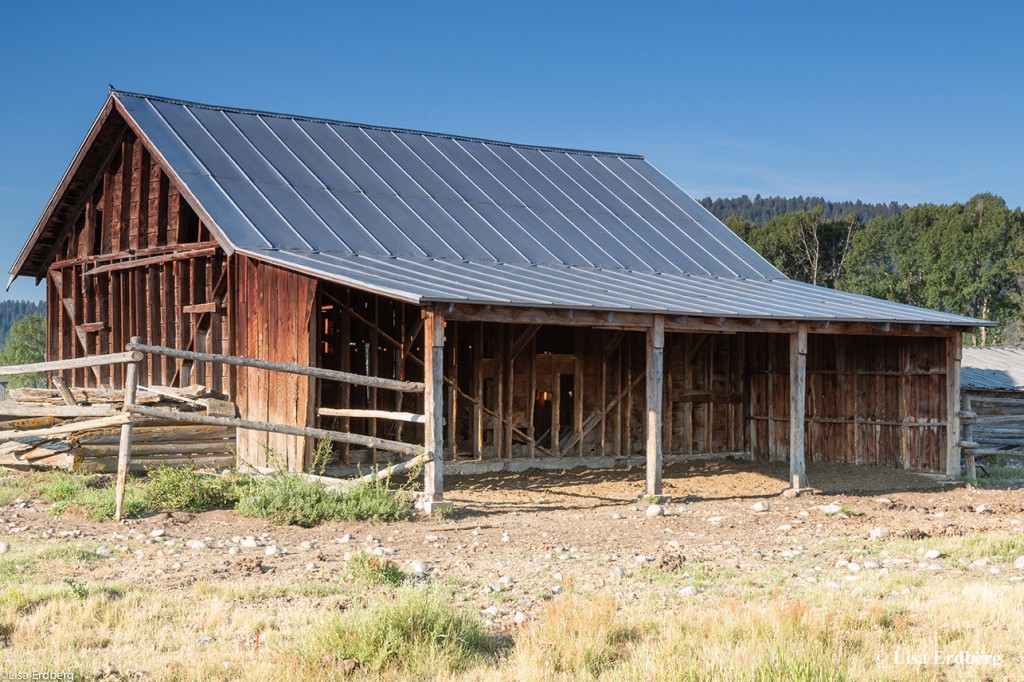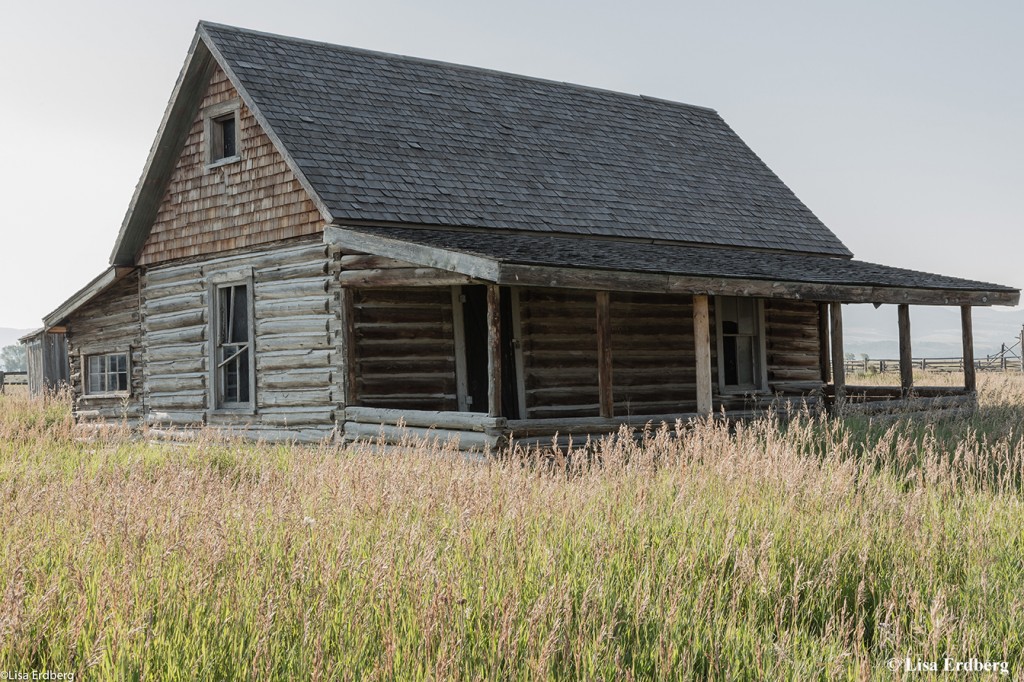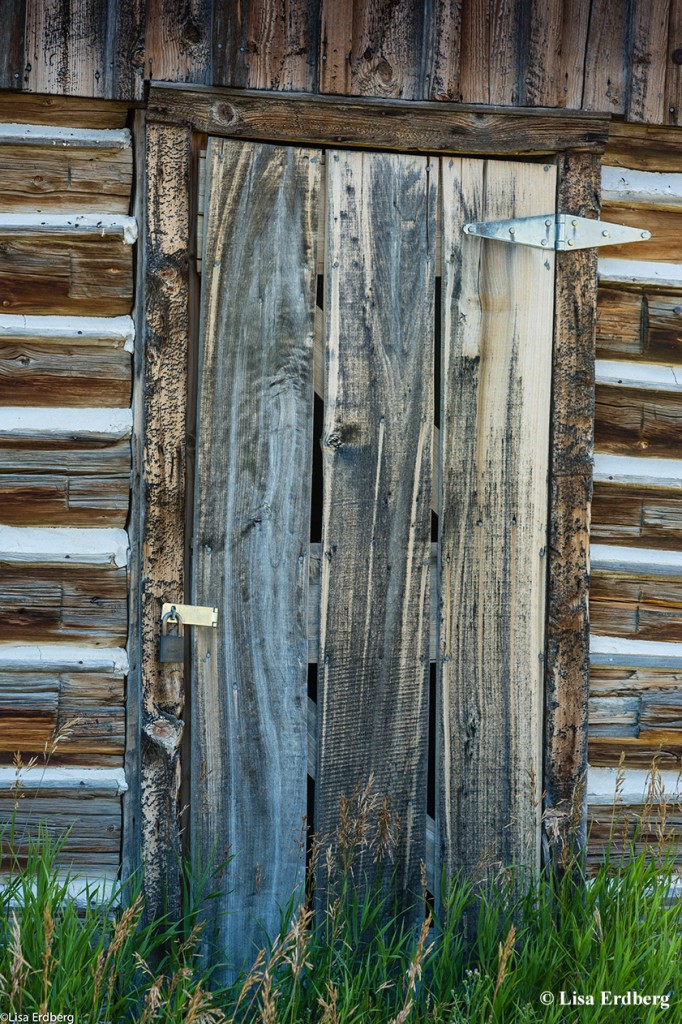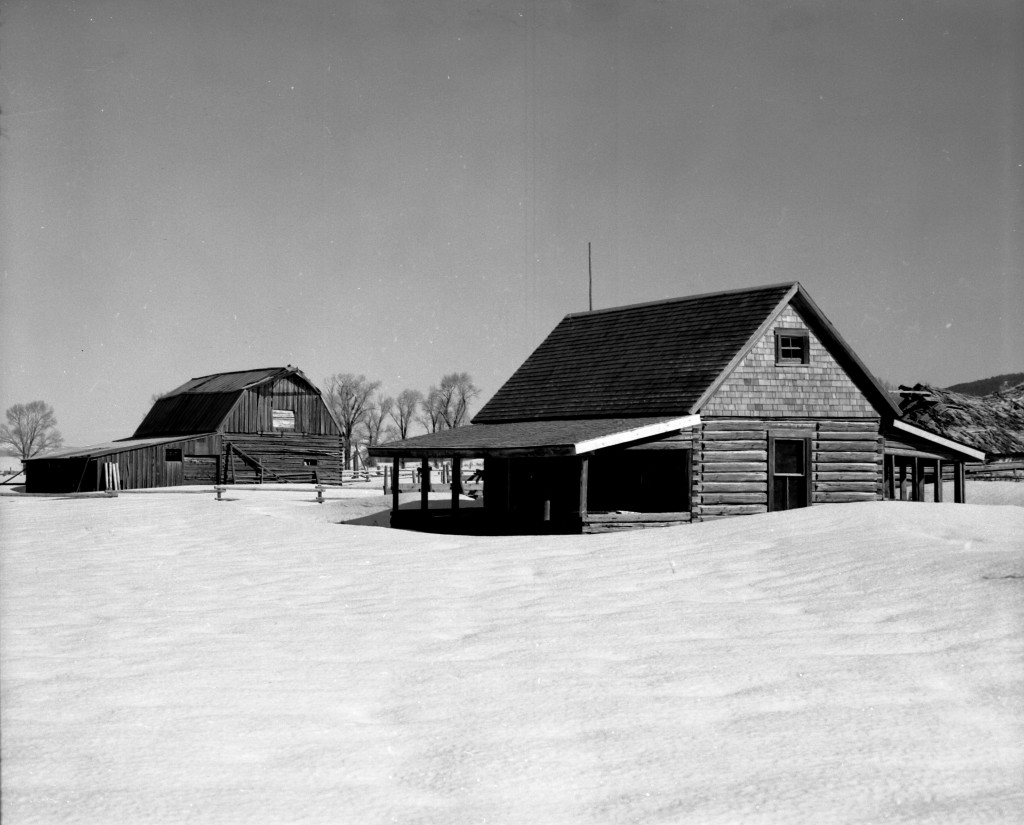In 1912, the Andy Chambers homestead was the last land claim filed on Mormon Row. Chambers was granted title to his land in 1917 after building a log cabin and stable. He cultivated 20 acres of land and had laid out the logs for a 2-story, four-room home. Because this homestead was the last to be built in the community of Grovont (“Gros Ventre” was determined too hard to spell by the U.S. Postal Service) it is Mormon Row’s best preserved example of a working ranch. Only a portion of the original buildings remain on the other four homesteads that are still visible today.
Mormon Row is an excellent example of the linear villages established by the Mormons in the West. According to their church, villages were to be orderly and built from “permanent” materials such as stone and brick. In Jackson Hole there were several allowances made to these rules, as availability of materials and tools limited the type of construction that could be done. All original homestead cabins were simple logs with sod roofs and packed dirt floors. When the family could afford to construct a larger house, the old cabin was dismantled and the wood was used for a variety of other purposes. Some of it was used for fuel to heat the church and school, some became fencing and some was incorporated into the new house. Nothing was wasted.
Built in 1917, the granary is an important part of the agricultural complex. It now stands outside the main fencing area, in a lot used and maintained by the NPS. This area creates a separate space that is now used to graze horses. The granary is an excellent reminder that this ranch was once used for hay production. Until the Kelly flood in 1927, the farms on the northern half of Mormon Row were dry farmed. This meant relying on natural rainfall to support your crops, as there was no reliable access to water. After the flood, Kelly Warm Springs began producing enough water to enable the men on Mormon Row to build a large irrigation ditch to service the community.
Water was a valuable resource in Jackson Hole. It dictated the pattern of settlement in the valley, and often determined whether or not a ranch would be successful. Those with access to good soil like Andy Chambers could survive, but the irrigation ditch was a welcome addition. Ranching on 160 acres was often a difficult task, as the acreage was rarely enough to support the working and residential building complexes along with enough land for raising hay and grazing cattle. Cattle were taken up into the mountains east of the Row during the summer months. When neighbors moved away, their homesteads were quickly purchased by those who remained. The vast grasslands surrounding these homesteads are a reminder of how much land they were able to clear and cultivate. While the sage is creeping back in, the agricultural landscape still dominates the terrain.
This small log and wood shingle house was built in the summer of 1916 by Andy Chambers. It was originally a two-room structure with two unfinished rooms on the second floor. A nursery and enclosed back porch were added to the building after 1945. The house served as a residence for the first few years until the Chambers family built a large, two-story wooden frame house. The construction of the new large house would have shifted the residential complex away from the agricultural infrastructure of the ranch. Most homesteads were divided in this way, with the “working” farm buildings being constructed apart from the residential buildings in order to separate the flow of the different activities. The original log house was converted to a bunkhouse for farm laborers when the Chambers family moved into their larger frame house.
This arrangement would unfortunately be short lived as the frame house burned to the ground in 1936. The old log house once again became the primary residence for the Chambers family. After Andy Chambers’ death in 1945, his son Roy purchased the adjacent Thomas Perry homestead and the residential complex shifted again as the family moved into the Perry home. The original log house now stands in what is a separated fenced yard of sorts, again removed from its association with the agricultural buildings to the north. The outhouse and pump house/garage have joined the log house in the residential complex. Even without the large frame house, this homestead still gives an accurate representation of what the entire Row would have looked like when it was still occupied.
Both the gas/oil house (right) and the machine shed (left) were constructed in 1917. They were built to operate as contributing members to the working, agricultural portion of the homestead. A fenced area delineates the agricultural buildings from the residential. The machine shed would have been used to store various farming equipment and to protect them from the elements. The shed is supported by a framing system with wooden planks making up the walls. Along with the oil house, these structures were built from less-permanent materials. They were intended to serve a specific purpose and constructed so that they could be easily moved or replaced. Like the houses and barns, these structures were vital to ranch operations. Unlike the houses and barns, they were seen as provisional, easily adaptable to the changing needs of agriculture.
Today, they stand under a very different use, temporary structures now tasked with surviving to serve as a permanent reminder of our past and heritage. They are important resources that require continued maintenance and protection from the elements. Built with the available materials at hand, and were changed very little but remained a source of pride for the resourceful individuals who built them and continued to use them for decades. The buildings on Mormon Row remind us that life here was successful, busy and productive.
This door is located on the garage/pump house building that was built in 1917. The pump house stands just northeast of the log home, incorporated into the residential complex by a fence. It was original used for storage space and later was converted into a laundry facility. The earlier homesteads on Mormon Row claim to have been built with lodgepole logs harvested from Timbered Island. It is possible that later homesteads, such as this one, would have also used logs from Shadow Mountain. (The best trees for building construction purposes were on Timbered Island, so it is probable these logs could have come from either location.)
The large spaces between the logs are filled with a material called chinking, often made from clay, mud or cement. Here cement is used, held in place by lathe, a type of construction used later on the Chambers homestead. Earlier log buildings used clay or mud for chinking as access to more modern materials like cement was very limited. These more modern materials are less susceptible to deterioration from the elements, as they are harder to break down than clay. However, continued exposure without maintenance can cause serious damage.




